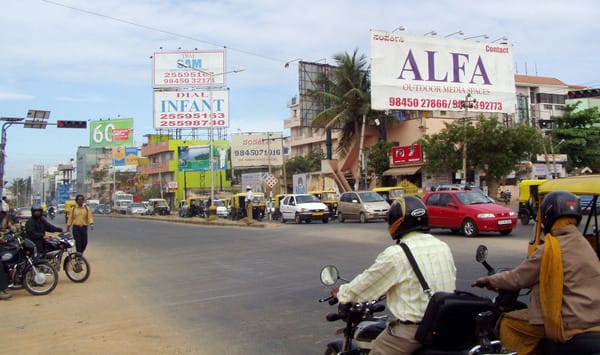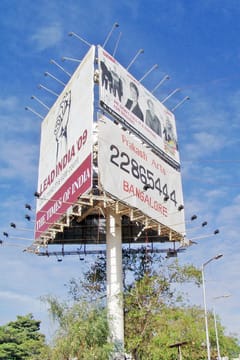Here’s one of the reasons why Bengaluru’s administrator BBMP has a severe fund-crunch. Every year BBMP budget expects crores of rupees to be collected as advertising revenue. But, the actual amount collected by the BMBP is way below expectations.
Budget estimates for 2012-13 predicted that the advertising department could bring in Rs. 45 crore, but the actual revenue collected from registered hoardings was only Rs.22 crore – thereby causing a deficit of 23 crores.
BBMP advertising department manager Lakshmi M has the reason: “Many advertisers who fail to pay their taxes or renew their license are considered as illegal advertisers. When we try to take action against them, they get a stay from the court. (So) their hoardings are left untouched.”
She informs that around 70 to 75 cases are pending in court, which cover various advertisers. Such hoardings are used by the advertisers, but the fee is not paid to BBMP. Thus the deficit arises.
File pic.
Though the Advertising Department has been pushing BBMP Legal cell to resolve the cases soon, there have been delays in court hearings, hence the cases are continuing forever, thereby causing financial loss to the BBMP Advertising Department.
This is just one side of the coin. Advertising Department has other problems to face, too.
Crores lost for various reasons
As it is, hoardings, if managed by BBMP directly, will be a great source of income. Now BBMP is letting private agencies erect hoardings and collects a fee from them, leaving the task of marketing to them. A BBMP document shows that a backlit hoarding measuring 30′ X 15′ erected in a prime location like M G Road, earns BBMP a meagre Rs 59,630 for 13 months.
However, a call to the Star Advertising Agency by Citizen Matters asking the price an advertiser needs to pay for the same hoardng received a reply that it is around Rs 1.75 to Rs 2 lakh per month. This means the amount paid to the BBMP is 1/35th of the actual revenue earned by the advertising agency.
The BBMP is also duped by illegal hoardings that are erected and operated with no permission from BBMP. The issue of low advertising hoarding revenues was raised by Mahalakshmipuram Councillor S Harish in a recent council meeting. He gave the example of a kilometre stretch of K R Puram road that had 20 illegal hoardings. He accused the Advertising Department of not keeping a check on such illegal hoardings.
Only 1997 hoardings registered
In all, BBMP has 1997 registered advertisement hoardings – 1616 commercial advertisements and 381 self-advertisements. East zone boasts of the maximum number of registered commercial advertisements, 765, followed by the South and West zones. Yelahanka zone has the least number of hoardings – 51 commercial and only five self-hoardings.
BBMP removed 259 illegal advertisements from Rajarajeshwari Nagar zone alone, and 125 illegal advertisements in South zone. In all, 727 illegal hoardings had been removed, as on July 2013, as per BBMP’s data. However, BBMP has not surveyed how many illegal hoardings are really there.

Hoardings available on Koramangala Inner Ring Road. File pic.
At the council meeting on August 28, 2013, BBMP Commissioner Lakshminarayan promised to set up a barcoding system to keep a check on the unauthorised hoardings and also promised to form a special team of officers to identify illegal advertisements and hoardings and submit its report within 30 days. 525 illegal hoardings were removed in this drive.
However, in another BBMP council meeting held on October 29, 2013, Corporators argued that there are more than 1,000 illegal hoardings still operating across the city.
On October 9, 2013, the High Court ordered BBMP to take immidiate action against illegal flexes, banners and hoardings. The court ordered to form a team of officers who shall inspect the eight zones twice a week in the night. On spotting any illegal hoardings, flexes or banners the officers should file a complaint on the concerned who erected it, in the local police station.
Following this, BBMP Commissioner formed an inspection team of Revenue Officers and drafted a notification. This notification is still not circulated to other zonal offices. Officials blame holidays for the delay.
Such actions are taken every year by each commissioner. Even last year, the then commissioner Rajneesh Goel and Siddhaiah had promised to form a team to remove illegal hoarding. In a well publicised drive, Rajneesh Goel removed some illegal hoardings from MG road and later announced plans for a barcoding system, to track authorised and unauthorised hoardings. Citizen Matters was unable to get details on this.
Citizens can act like a third eye
Lakshmi says citizens can help BBMP in identifying illegal hoardings. They can give a written complaint in writing or via mail (bbmp.advertising@gmail.com) or verbally on telephone. Complaint must be directed to the BBMP Commissioner, Assistant Commissioner or the respective Zonal Joint Commissioner. On receiving the complaint, the Department will inspect the hoarding; If found to be un-registered, it will be removed.
Here’s a small checklist you can use to spot illegal hoardings.
- Look out for registration number! This number should be displayed/ painted in white font color on the left of the hoarding over a black background color. If failed to oblige, Commissioner can send them a show cause notice. If the advertiser continues to violate, bye-law directs the Commissioner to take the responsibility and get it painted and levy a fine of Rs.2,500 for the expense incurred on behalf of the advertiser.
- Hoardings if put up on the private land should procure NOC from the owner of the land.
- No advertisement should project beyond the general line of the building or property onto the street for which a building or property line has been prescribed or within 10 meters measured on the same side of the road from any public park or pleasure promenade.
- No advertising is allowed to obstruct the opening and closing of any window/ door of residential building/ commercial establishment.
- No hoarding shall be within 3.5 metres from an uncovered electrical transformer of an un-insulated electrical wire.
- No advertisements will be displayed in public property like parks, gardens, and flyover unless it is a signage that is specifically permitted for a purpose/ period by the Commissioner.
- Hoardings which are continued under specific orders/directions of court of law shall display its details along with name of the agency and case number in black letters against yellow background. Failing this it will be termed as illegal hoarding.
- Some advertising agencies mention smaller size for a hoarding and pay the BBMP for that size, but in reality erect larger hoardings. If there’s notable difference in the size of the hoarding, it can be brought to the BBMP’s notice.
However, Lakshmi says the department does not penalise the violators. Citizen Matters pointed that Section 2 (3)(A)(7) of the Advertising Bye-law clearly mentions that any unauthorised advertisement shall attract penalty. However Lakshmi seemed unaware about it.
For any general violation with regard to all types of advertisements, advertising Bye-law asks the Commissioner to send a show cause notice and penalise the concerned agency at a rate not less than the maximum prescribed.
On violation for the first time fine of Rs.3,000 will be imposed on second time the amount will increase to Rs. 5,000. If the violation continues a sum of Rs. 10,000 will be fined along with the cancellation of trade license or any other license awarded by the Corporation.
– BBMP Advertising Bylaw, 2006
How to spot an illegal hoarding?
Section 2, Norms for outdoor advertisement 3 (A) (14c) (Vii) of the Advertising Bye-law clearly states that the permit number shall be painted on the left in white against a black metallic strip along with the name of the agency should be affixed to the hoarding immediately below the vinyl/flex/painted hoarding. Have you spotted it on hoardings? If not, it could be illegal.
Section 2, Norms for outdoor advertisement 3 (A) (16) clearly says that whoever breaches the rules mentioned in the bye-laws should be issued a showcause notice.
A grace period of seven days will given to the violator to reply to the commissioner’s notice. On failing to give a reply to the notice and continuing the violation of the rules, a fine of Rs. 5,000 will be imposed. The rules also cover per-day penalty (Rs 500-750) for violators till they comply with the rules.
Some common rules that you can keep an eye on
Bangalore is divided into four zones – A, B, C and D – for regulating the locations and display of advertisement hoardings in the city. These zones have their own limitations on various aspects like number of hoardings or the nature of advertisements: height or size of the display of advertisement, distance between two ads etc.
Zone A includes areas like Raj Bhavan Road, Post office Road, K R Circle, Environs of Cubbon Park, Lalbagh and Palace road.
Zone B comprises of Sheshadari road, Kamaraj road, Queens road, Cubbon road, M G Road, Brigade road, R V road, Commercial Street.
Zone C includes the Old Bangalore, Yesvantpur Circle, Mekhri Circle, 100 feet road Indiranagar, Sampige road, Margosa road etc. This list goes on with 71 names while zone D has 72 names which is mix of far flung areas and highly populated areas of the city llike Tumkur road, Outer ring road, Peenya Industrial Area, Mathikere main Road, New BEL Road, Hosur road, Bull temple road, KH road, Kanakapura road, Bannerghatta, Sarjapur road etc.
Areas that fall under zone A are restricted from displaying any hoardings. In zones B, C, and D, hoardings can be displayed on either sides of the road. The height and size restrictions for various zones are listed below, the violation of which makes the hoarding illegal.
| Parameters | Zone B | Zone C | Zone D |
| Size | Not exceed 24 feet by 12 feet when erected on ground. When erected on rooftop it should not exceed 30 by 15 feet. |
Not exceed 40 by 20 | Not exceed 40 by 20 |
| Height | The height of the hoarding shall not exceed 40 feet from the ground. | Not exceed 50 feet from the ground. | No height restrictions. No hoarding will be permitted to be placed one above the other if the Ad is erected on rooftop. Otherwise no restriction. |
| Distance | Minimum distance between two hoarding shall be 1 metre | Minimum distance between two hoarding shall be 1 metre | Minimum distance between two hoarding shall be 1 metre |
| Exceptions to this general rule will be considered if this helps to reduce the number of hoardings with a view to enhance visual and aesthetic value of the landscape. |
However, all these rules remain only in the paper, in the absense of informed citizenry and committed officials to stop illegal hoardings.
Related Articles
BBMP rids the city of unauthorised hoardings
Trees are not advertising billboards

The entire Bangalore City Roads/Streets become CARs parking zone in front of houses on the roads. So why do not you impose fine or collect monthly rental charges so that your revenue will generate. Parking cars on residential roads are illegal.
Local ward committee members can be given powers to identify illegal hoarding and do the spot fine thru bbmp office so that bbmp can earn good income. BBMP should seriously think of ways and means to generate revenue.